Sustainable Cities in the Light of ISO 37120 and 37101 Standards: A Systematic Review and the Contribution of a Theoretical Framework
Abstract
1. Introduction
2. Theoretical Framework
Sustainable Cities and Communities and ISO 37120
3. Methodological Procedures
4. Discussion
4.1. Descriptive Analysis
4.2. Content Analysis
4.2.1. Analysis Category 1 (Class 2)—Metrics and Performance
4.2.2. Analysis Category 2 (Class 1)—Open Data, Knowledge and Infrastructure
4.2.3. Analysis Category 3 (Class 3)—Sustainability and Sustainable Development Goals (SDGs)
4.2.4. Framework
5. Conclusions
Author Contributions
Funding
Data Availability Statement
Conflicts of Interest
References
- Neirotti, P.; De Marco, A.; Cagliano, A.C.; Mangano, G.; Scorrano, F. Current trends in Smart City initiatives: Some stylised facts. Cities 2014, 38, 25–36. [Google Scholar] [CrossRef]
- de Oliveira, J.C.; Mazieri, M.R.; Kniess, C.T. Smart cities indicators: How regional context and its stakeholders are essential to name “the” smart city. J. Urban Technol. 2024, 31, 73–96. [Google Scholar] [CrossRef]
- Silva, C.F.R.; Vargas, M.A.M. Sustentabilidade urbana: Raízes, conceitos e representações. Sci. Plena 2010, 6. Available online: https://www.scientiaplena.org.br/sp/article/view/158 (accessed on 25 January 2025).
- Kniess, C.T.; Philippi, A., Jr.; Aguiar, A.D.O.E.; Conti, D.D.M. Inovação urbana e recursos humanos para gestão de cidades sustentáveis. Estud. Avançados 2019, 33, 119–135. [Google Scholar] [CrossRef]
- Batty, M.; Axhausen, K.W.; Giannotti, F.; Pozdnoukhov, A.; Bazzani, A.; Wachowicz, M.; Ouzounis, G.; Portugali, Y. Smart cities of the future. Eur. Phys. J. Spec. Top. 2012, 214, 481–518. [Google Scholar] [CrossRef]
- Hernández-Muñoz, J.M.; Vercher, J.B.; Muñoz, L.; Galache, J.A.; Presser, M.; Gómez, L.A.H.; Pettersson, J. Smart cities at the forefront of the future internet. Future Internet Assem. 2011, 6656, 447–462. [Google Scholar]
- ISO 37120:2021; Sustainable Cities and Communities—Indicators for Urban Services and Quality of Life. International Organization for Standardization: Geneva, Switzerland, 2021.
- ONU. Cidades e Comunidades Sustentáveis. 2015. Available online: https://nacoesunidas.org/pos2015/ods11/ (accessed on 25 January 2025).
- ISO 37101:2016; Sustainable Development in Communities—Management System for Sustainable Development—Requirements with Guidance for Use. International Organization for Standardization: Geneva, Switzerland, 2016.
- Stéfani, S.R.; Barros, V.; Gandra, E.; do Carmo, H.P.M. Digital City and the Objectives of Sustainable Development. In Springer Proceedings in Earth and Environmental Sciences, 1st ed.; Almeida, F.L., Morais, J.C., Santos, J.D., Eds.; Springer Nature: Cham, Switzerland, 2024; pp. 125–132. [Google Scholar] [CrossRef]
- Stéfani, S.R.; Peixoto, J.P.; Santos, P.C.; Ferreira, R.M.; Chiusoli, C.L.; Rodrigues, C.S. ISO 37120 Indicators for Sustainable Cities: Brazil and Portugal. Rev. De Gestão Soc. E Ambient. (ANPAD) 2024, 18, e05328. [Google Scholar] [CrossRef]
- Chovancová, J.; Petruška, I.; Pata, U.K. A Cross-National Study on Sustainable Smart City Indicators and Their Influence on Life Expectancy—A Cluster Analysis of EU Countries. Urban Sci. 2024, 8, 164. [Google Scholar] [CrossRef]
- Zaias, L.J.D.L.; Stefani, S.R.; Kos, S.R. ISO 37120 and the 2030 Agenda for Sustainable Development in a City in the South-Central Region of Paraná: The Citizens’ View-Revista Capital Científico–Eletrônica (RCCe). 2023. Available online: https://revistas.unicentro.br/index.php/capitalcientifico/article/view/7190 (accessed on 25 January 2025).
- Müller, L.; Leal da Silva, T.; Ribeiro, L.A. Sustainable community development-applicability and global contextualization of urban indicators. Rev. Adm. UFSM 2020, 13, 1441–1458. [Google Scholar] [CrossRef]
- Abiko, A. ABNT Publishes the Revision of the Standard NBR ISO 37120:2021. Available online: https://www.linkedin.com/pulse/abnt-publica-revis%C3%A3o-da-norma-nbr-iso-371202021-cidades-alex-abiko/ (accessed on 25 January 2025).
- ABNT-CEE-268; Brazilian Association of Technical Standards-Gt1–Working Group for the Preparation of NBRs. ABNT: São Paulo, Brazil, 2025. Available online: http://cbcs.org.br/_5dotSystem/userFiles/CT%20Urbano/ABNT%20CEE%20268%20GT1.pdf (accessed on 25 January 2025).
- Picalho, A.C.; Lucas, E.R.O.; Amorim, I.S. Boolean logic applied to the construction of search expressions. AtoZ New Pract. Inf. Knowl. 2022, 11, 1–12. [Google Scholar]
- Zipf, G.K. Human Behaviour and the Principle of Least Effort: An Introduction to Human Ecology; Addison-Wesley Press Inc.: Cambridge, MA, USA, 1949. [Google Scholar]
- Batista, R.A.S.; Brandalise, M.; Ângela, T. Avaliação das aprendizagens em História: Uma proposta para Aprendizagem Baseada em Projetos (ABP). Ensino Em Re-Vista 2023, 30, e001. [Google Scholar] [CrossRef]
- Bardin, L. Análise de Conteúdo; Edições: São Paulo, Brazil, 2011; p. 70. [Google Scholar]
- Salviati, M.E. Iramuteq application manual. Retrieved March 2017, 3, 2020. [Google Scholar]
- Urbizagastegui, R. A produtividade dos autores sobre a Lei de Lotka. Ciênc. Inf. 2008, 37, 87–102. [Google Scholar] [CrossRef]
- Mandják, T.; Lavissière, A.; Hofmann, J.; Bouchery, Y.; Lavissière, M.C.; Faury, O.; Sohier, R. Port marketing from a multidisciplinary perspective: A systematic literature review and lexicometric analysis. Transp. Policy 2019, 84, 50–72. [Google Scholar] [CrossRef]
- Bibri, S.E. A foundational framework for smart, sustainable city development: Theoretical, disciplinary, and discursive dimensions and their synergies. Sustain. Cities Soc. 2018, 38, 758–794. [Google Scholar] [CrossRef]
- Steiniger, S.; Wagemann, E.; de la Barrera, F.; Molinos-Senante, M.; Villegas, R.; de la Fuente, H.; Vives, A.; Arce, G.; Herrera, J.C.; Carrasco, J.A.; et al. Localizing urban sustainability indicators: The CEDEUS indicator set, and lessons from an expert-driven process. Cities 2020, 101, 102683. [Google Scholar] [CrossRef]
- European Parliament. Mapping Smart Cities in the EU. Document IP/A/ITRE/ST/2013-02 PE 507.480. 2014. Available online: https://www.europarl.europa.eu/portal/en (accessed on 27 October 2024).
- Shamsuzzoha, A.; Nieminen, J.; Piya, S.; Rutledge, K. Smart city for a sustainable environment: A comparison of participatory strategies from Helsinki, Singapore, and London. Cities 2021, 114, 103194. [Google Scholar] [CrossRef]
- Weiss, M.C. Smart Cities: An Overview of the Research Agenda in Information Technology. Braz. J. Manag. Innov. 2019, 162–187. [Google Scholar] [CrossRef]
- Sinclair, M.A.; Henshaw, M.D.; Henshaw, S.L. On building sustainable communities: A perspective for HFE practitioners. Appl. Ergon. 2021, 96, 103476. [Google Scholar] [CrossRef] [PubMed]
- Masik, G.; Sagan, I.; Scott, J.W. Smart City strategies and new urban development policies in the Polish context. Cities 2021, 108, 102970. [Google Scholar] [CrossRef]
- Bibri, S.E.; Krogstie, J. On the social shaping dimensions of smart, sustainable cities: A study in science, technology, and society. Sustain. Cities Soc. 2016, 29, 219–246. [Google Scholar] [CrossRef]
- Nam, T.; Pardo, T.A. Conceptualizing a smart city with dimensions of technology, people, and institutions. In Proceedings of the 12th Annual International Conference on Digital Government Innovation in Challenging Times, College Park, MD, USA, 12–15 June 2011; ACM: New York, NY, USA, 2011. [Google Scholar]
- Tsolakis, N.; Anthopoulos, L. Eco-cities: An integrated system dynamics framework and a concise research taxonomy. Sustain. Cities Soc. 2015, 17, 1–14. [Google Scholar] [CrossRef]
- Shmelev, S.E.; Shmeleva, I.A. Multidimensional sustainability benchmarking for smart megacities. Cities 2019, 92, 134–163. [Google Scholar] [CrossRef]
- Garrido-Piñero, J.; Mercader-Moyano, P. EIAMUO methodology for environmental assessment of the post-war housing estates renovation: Practical application in Seville (Spain). Environ. Impact Assess. Rev. 2017, 67, 124–133. [Google Scholar] [CrossRef]
- Gonzalez-Garcia, S.; Rama, M.; Cortés, A.; Garcia-Guaita, F.; Nunez, A.; Louro, L.G.; Moreira, M.T.; Feijoo, G. Embedding environmental, economic, and social indicators in the evaluation of the sustainability of the municipalities of Galicia (northwest of Spain). J. Clean. Prod. 2019, 234, 27–42. [Google Scholar] [CrossRef]
- Machado Junior, C.; Mantovani, D.; Pereira, R.; Bazanni, R. Do Brazilian cities want to become smart or sustainable? J. Clean. Prod. 2018, 199, 214–221. [Google Scholar] [CrossRef]
- Botton, G.Z.; Pinheiro, L.K.S.; Oliveira, M.C.J.; Vasconcelos, A.M.; de Jesus Lopes, J.C. The construction of conceptual approaches to sustainable and smart cities to overcome the challenges of the sustainable development goals. Desafio Online 2021, 3, 9. [Google Scholar] [CrossRef]
- Yang, R.; Zhen, F. Smart city development Models: A cross-cultural regional analysis from theory to practice. Res. Glob. 2024, 8, 100221. [Google Scholar] [CrossRef]
- Zhang, X.; Du, S.; Zhang, J. How do people understand convenience-of-living in cities? A multiscale geographic investigation in Beijing. ISPRS J. Photogramm. Remote Sens. 2019, 148, 87–102. [Google Scholar] [CrossRef]
- Fernandes, P.M.D.S. IBRACHICS–Brazilian Institute of Humane, Intelligent, Creative and Sustainable Cities. Crit. J. Soc. Sci. 2023, 130, 196–198. [Google Scholar] [CrossRef]
- Papamichael, I.; Voukkali, I.; Loizia, P.; Pappas, G.; Zorpas, A.A. Existing tools used in the framework of environmental performance. Sustain. Chem. Pharm. 2023, 32, 101026. [Google Scholar] [CrossRef]
- Wojewnik-Filipkowska, A.; Gierusz-Matkowska, A.; Krauze-Máslankowsk, P. Fundamental power of the city—A proposition of a new paradigm and index for city development. Cities 2024, 144, 104630. [Google Scholar] [CrossRef]
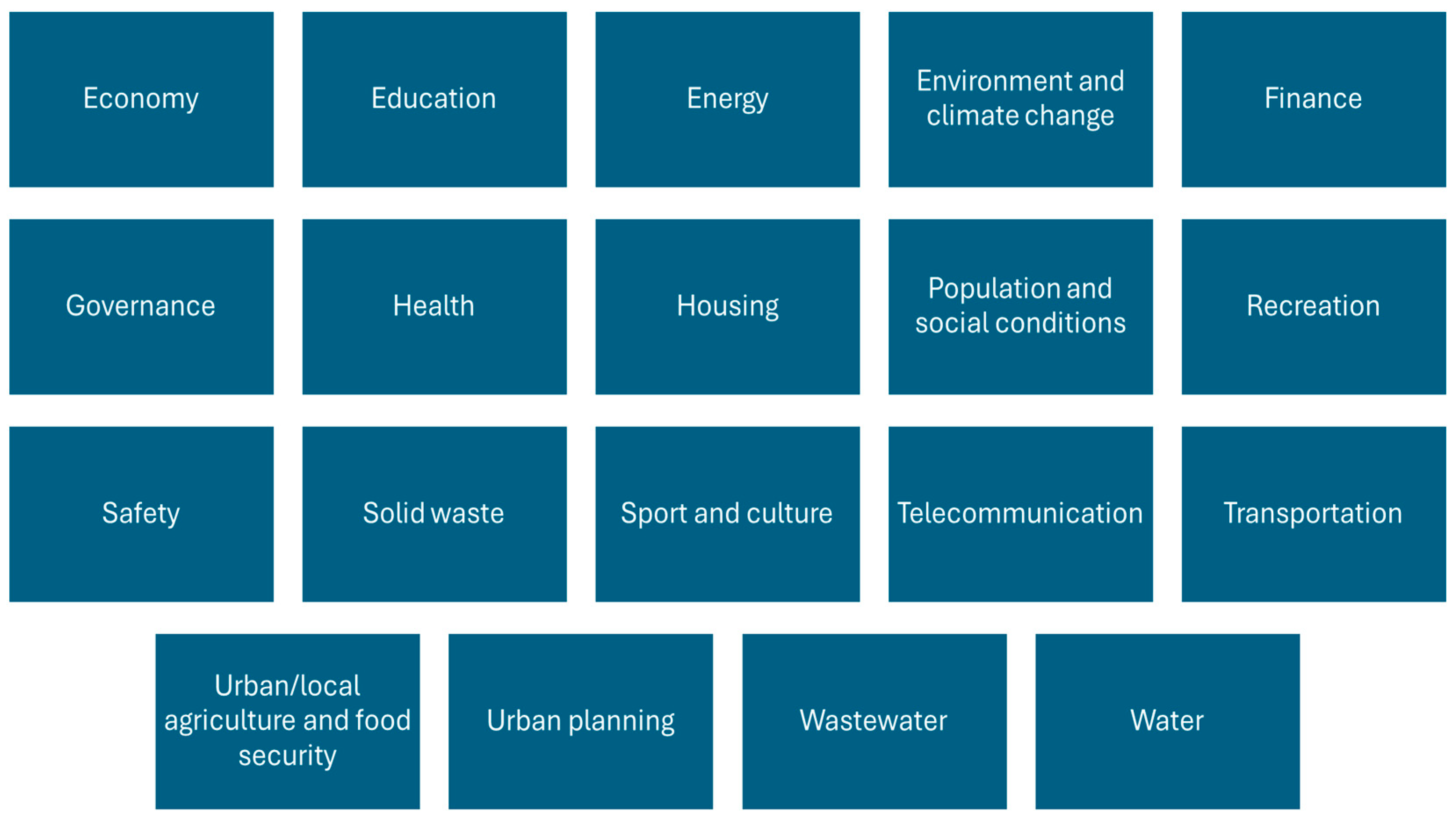
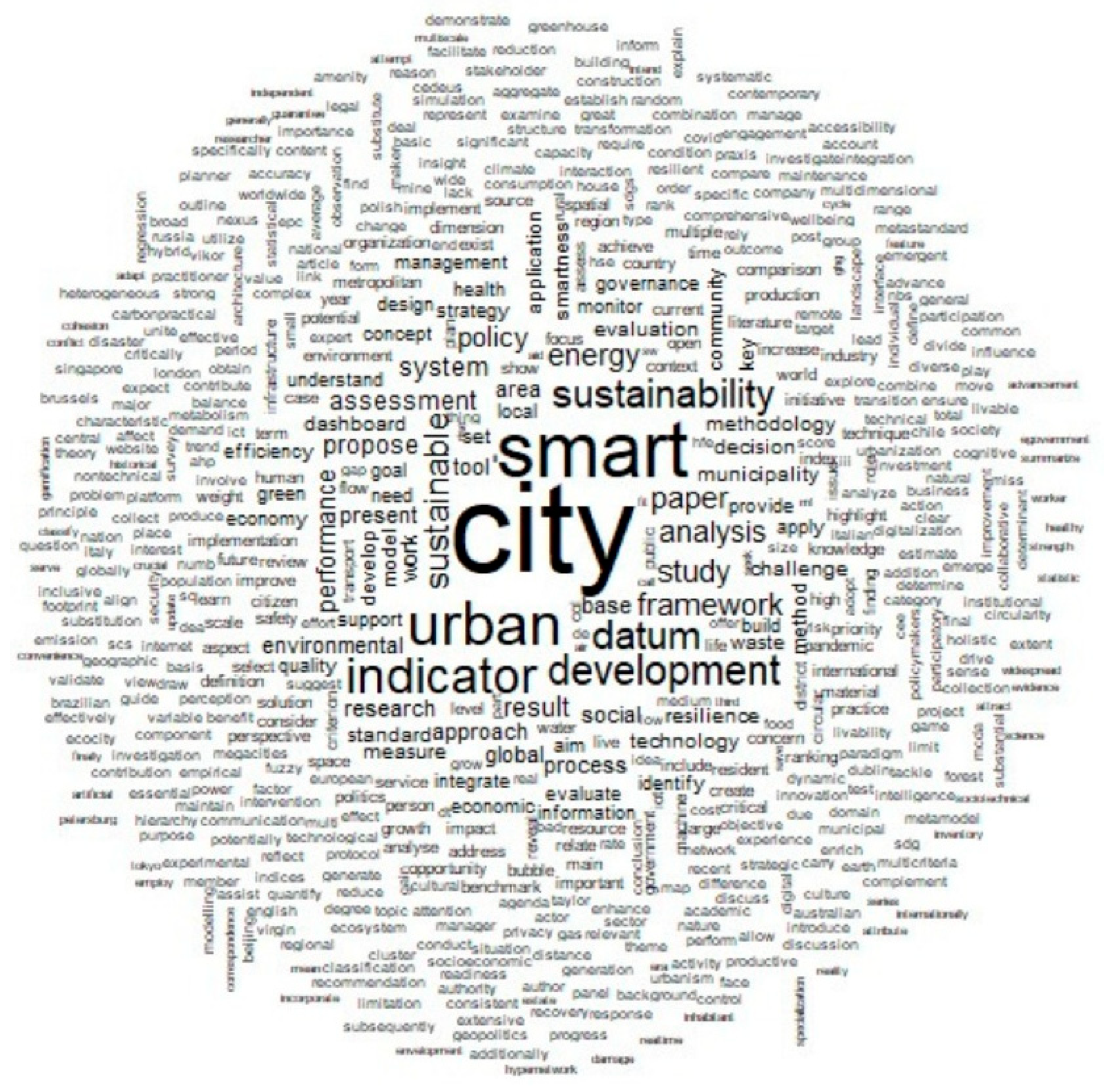

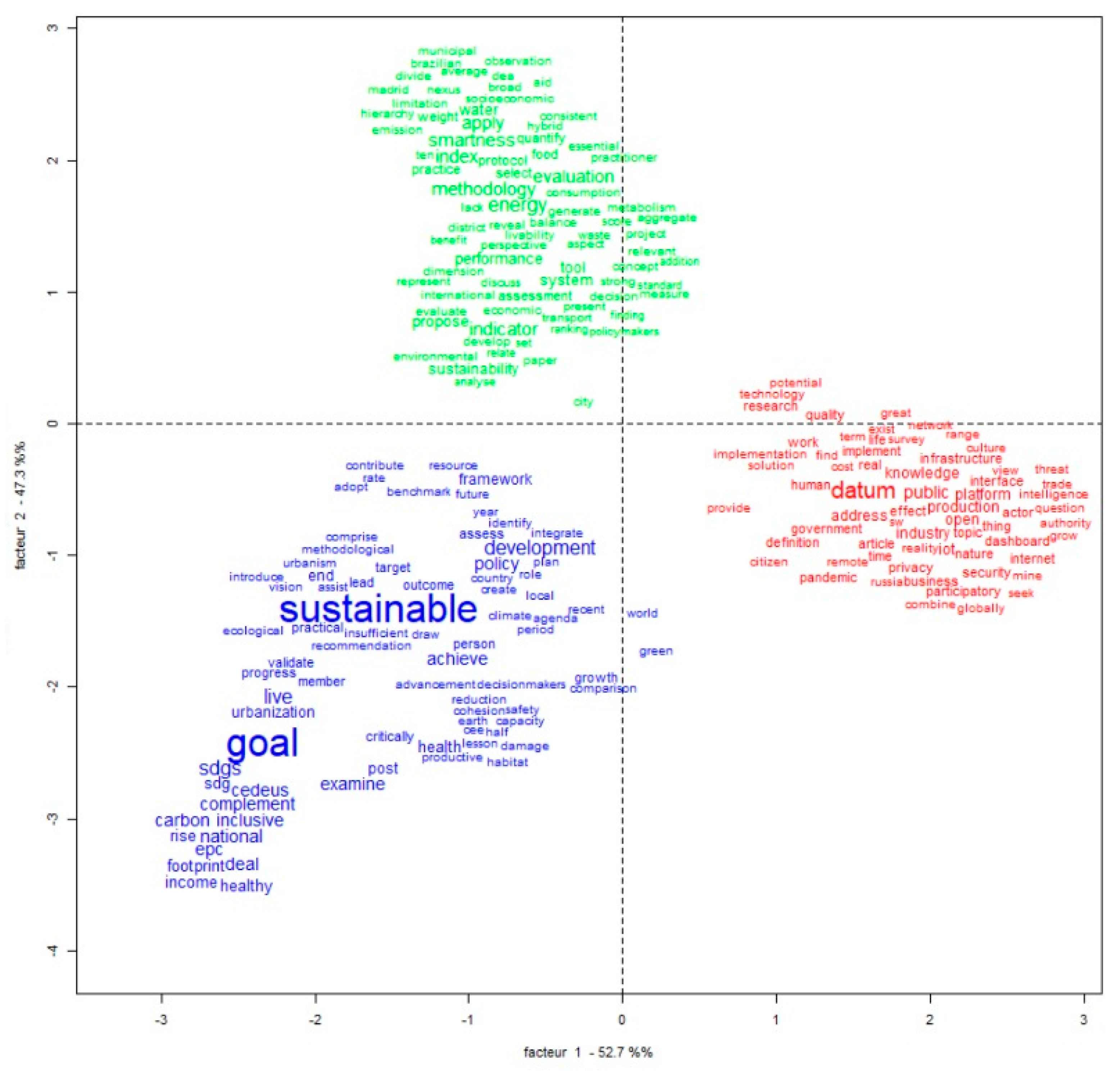
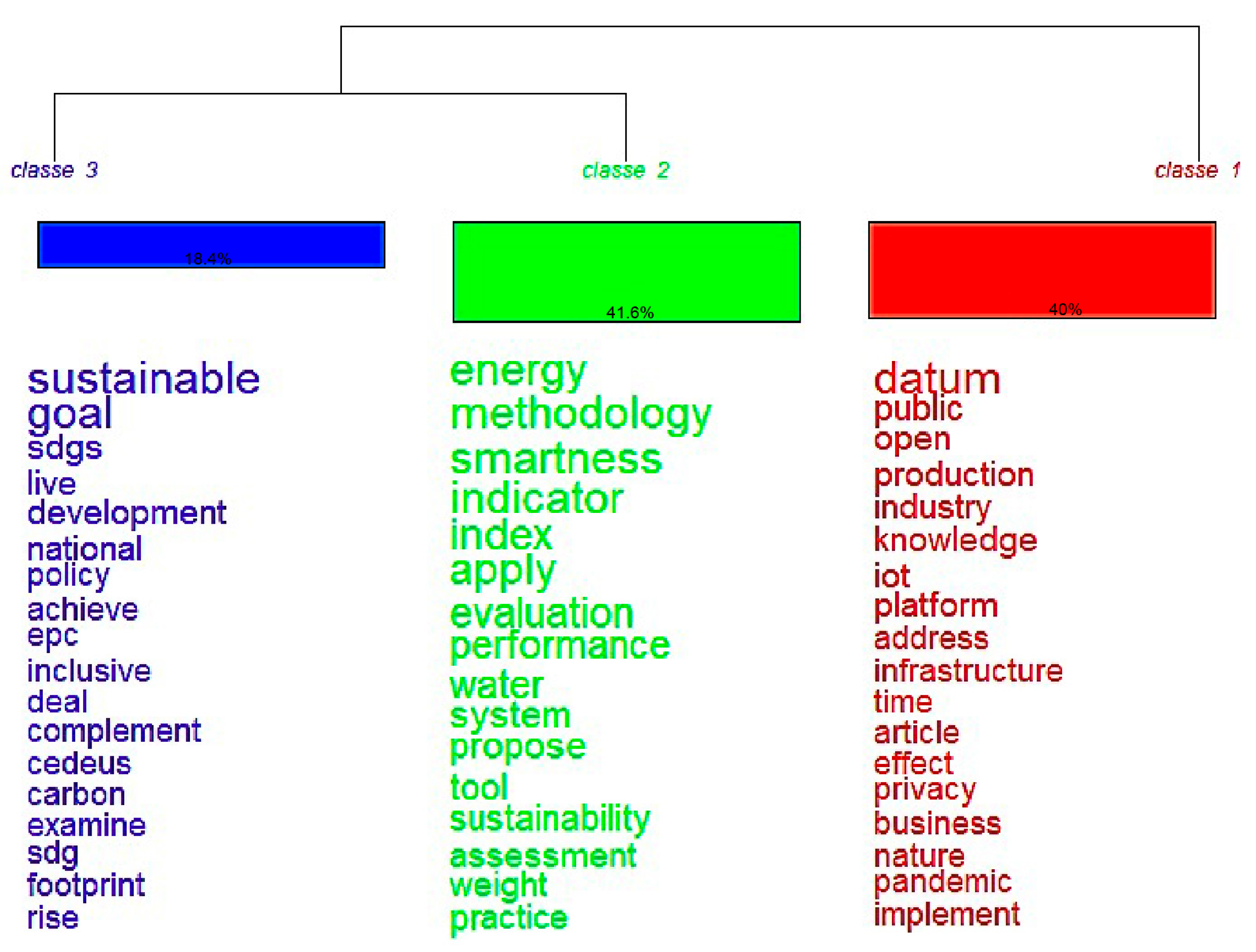
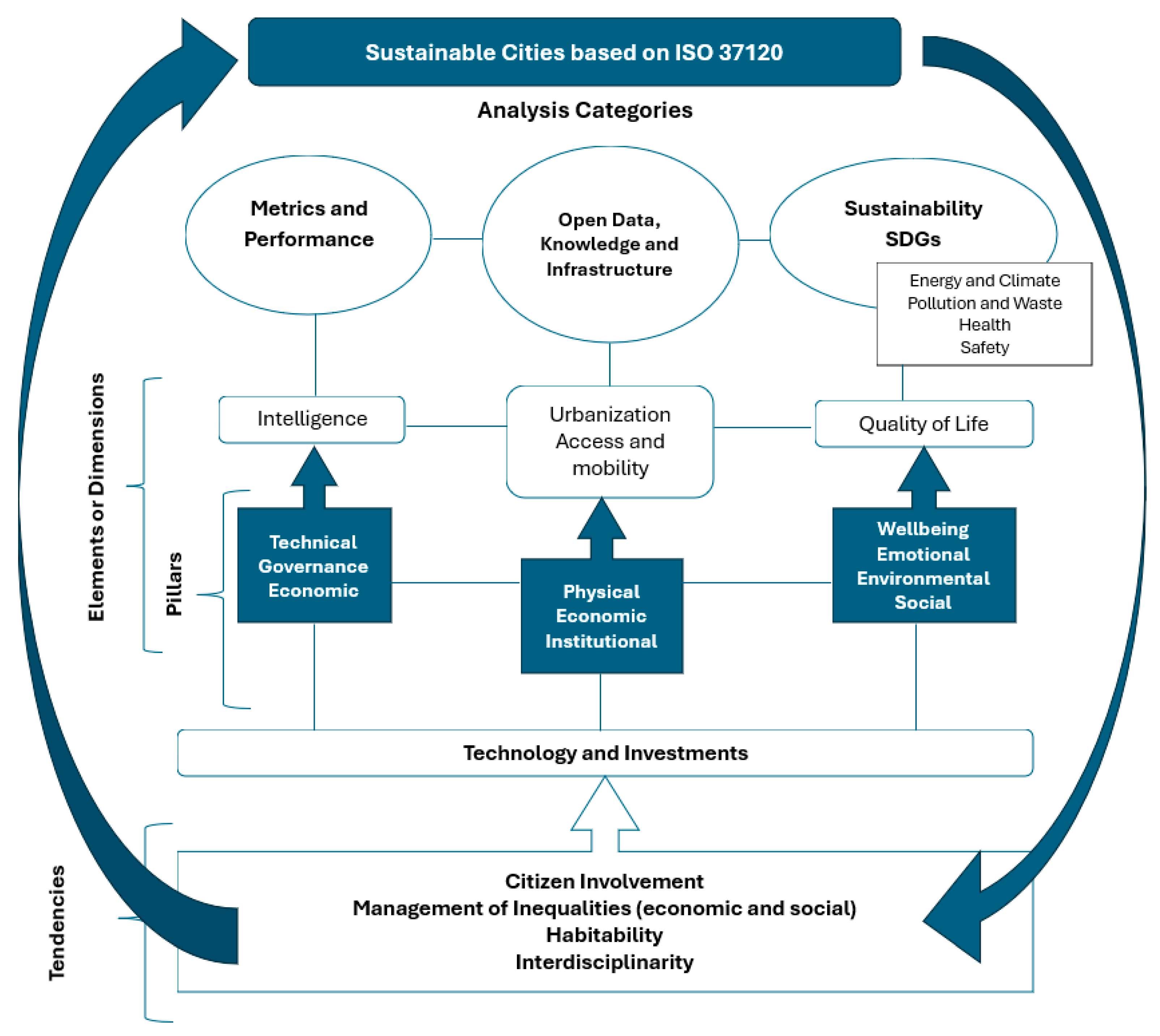
| Base | ISO 37120 OR ISO 37101 | Period Last 10 Years |
|---|---|---|
| Web Of Science | 48 | 48 |
| Scopus | 40 | 40 |
| Science Direct | 148 | 131 |
| Overall | 236 | 219 |
| Most Cited Authors | ||
| n = 7 | Sławomira Hajduk | |
| n = 5 | Mark S. Fox | |
| n = 3 | Iliana Papamichael | Maria-Lluïsa Marsal-Llacuna |
| Fernando A.F. Ferreira | James Merricks White | |
| Antonis A. Zorpas | ||
| Authors with 2 citations | ||
| Aapo Huovila | Giuliano Dall’O’ | Matthew Jull |
| Adam Przybylowski | Gumersindo Feijoo | Miimu Airaksinen |
| Adeeb A. Kutty | H C Melo | Murat Kucukvar |
| Agnieszka Kałaska | H S Dantas | Nuri C. Onat |
| Angela Panza | Irene Voukkali | Pantelitsa Loizia |
| Antonios Maitis | John R. Vacca | Piotr Przybyłowski |
| Athena Vakali | Jose M. Diaz-Sarachaga | Rob Kitchin |
| Benjamin DiNapoli | Kannan Govindan | Sara González-García |
| Daniel Jato-Espino | Leandro F. Pereira | Suane De Atayde Moschen |
| Dongping Fang | Leonidas G. Anthopoulos | Suélen Bebber |
| Elisa Bruni | Luca Sarto | Tan Yigitcanlar |
| Fazel Khayatian | Manuel Rama | Vaia Moustaka |
| Galal M. Abdella | Marcelo B. Corrêa da Silva | Zeyu Zhao |
| Georgios Pappas | Maria Teresa Moreira | |
| Keywords | n | % |
|---|---|---|
| Smart Cit * | 64 | 7.2% |
| ISO 37120 OR ISO 37101 | 27 | 3.0% |
| Sustainable development | 17 | 1.9% |
| Indicators | 13 | 1.5% |
| Urban planning | 10 | 1.1% |
| Sustainability | 10 | 1.1% |
| Other words | 745 | 84.1% |
Disclaimer/Publisher’s Note: The statements, opinions and data contained in all publications are solely those of the individual author(s) and contributor(s) and not of MDPI and/or the editor(s). MDPI and/or the editor(s) disclaim responsibility for any injury to people or property resulting from any ideas, methods, instructions or products referred to in the content. |
© 2025 by the authors. Licensee MDPI, Basel, Switzerland. This article is an open access article distributed under the terms and conditions of the Creative Commons Attribution (CC BY) license (https://creativecommons.org/licenses/by/4.0/).
Share and Cite
Spiri-Ferreira, T.; Zarelli, P.R.; Stefani, S.R.; Bertolini, G.R.F.; Barros, V.F.d.A.; Kniess, C.T.; Sotto, D.; Cortese, T.T.P. Sustainable Cities in the Light of ISO 37120 and 37101 Standards: A Systematic Review and the Contribution of a Theoretical Framework. Urban Sci. 2025, 9, 368. https://doi.org/10.3390/urbansci9090368
Spiri-Ferreira T, Zarelli PR, Stefani SR, Bertolini GRF, Barros VFdA, Kniess CT, Sotto D, Cortese TTP. Sustainable Cities in the Light of ISO 37120 and 37101 Standards: A Systematic Review and the Contribution of a Theoretical Framework. Urban Science. 2025; 9(9):368. https://doi.org/10.3390/urbansci9090368
Chicago/Turabian StyleSpiri-Ferreira, Thiago, Paula Regina Zarelli, Silvio Roberto Stefani, Geysler Rogis Flor Bertolini, Victor Freitas de Azeredo Barros, Cláudia Terezinha Kniess, Debora Sotto, and Tatiana Tucunduva Philippi Cortese. 2025. "Sustainable Cities in the Light of ISO 37120 and 37101 Standards: A Systematic Review and the Contribution of a Theoretical Framework" Urban Science 9, no. 9: 368. https://doi.org/10.3390/urbansci9090368
APA StyleSpiri-Ferreira, T., Zarelli, P. R., Stefani, S. R., Bertolini, G. R. F., Barros, V. F. d. A., Kniess, C. T., Sotto, D., & Cortese, T. T. P. (2025). Sustainable Cities in the Light of ISO 37120 and 37101 Standards: A Systematic Review and the Contribution of a Theoretical Framework. Urban Science, 9(9), 368. https://doi.org/10.3390/urbansci9090368








